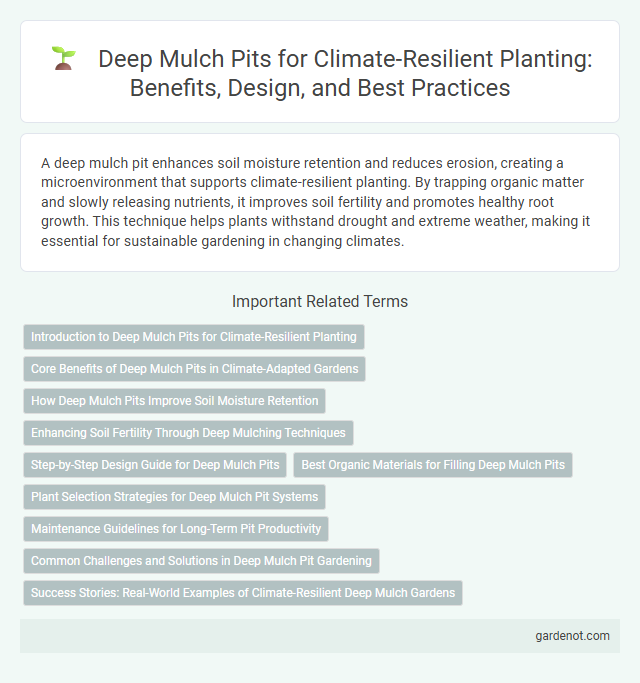A deep mulch pit enhances soil moisture retention and reduces erosion, creating a microenvironment that supports climate-resilient planting. By trapping organic matter and slowly releasing nutrients, it improves soil fertility and promotes healthy root growth. This technique helps plants withstand drought and extreme weather, making it essential for sustainable gardening in changing climates.
Introduction to Deep Mulch Pits for Climate-Resilient Planting
Deep mulch pits enhance soil moisture retention and reduce evaporation, making them essential for climate-resilient planting in arid and drought-prone regions. These pits capture and store rainwater, improving nutrient availability and fostering deeper root growth. Integrating deep mulch pits into agricultural practices boosts crop survival and yields under changing climatic conditions.
Core Benefits of Deep Mulch Pits in Climate-Adapted Gardens
Deep mulch pits improve soil moisture retention by reducing evaporation, crucial for climate-resilient planting in arid regions. These pits enhance nutrient availability by concentrating organic matter, leading to healthier plant growth and increased drought tolerance. Their design also supports microclimate stabilization, mitigating temperature extremes to protect sensitive crops in climate-adapted gardens.
How Deep Mulch Pits Improve Soil Moisture Retention
Deep mulch pits enhance soil moisture retention by creating a microenvironment that reduces evaporation and allows water to infiltrate deeply into the soil profile. The organic mulch within the pits slowly decomposes, releasing nutrients and increasing soil organic matter, which improves water-holding capacity. This technique supports drought resilience by maintaining consistent moisture levels vital for plant root development.
Enhancing Soil Fertility Through Deep Mulching Techniques
Deep mulch pits improve soil fertility by retaining moisture and promoting microbial activity essential for nutrient cycling. This technique involves layering organic matter deeply around plant roots, which decomposes slowly and releases nutrients steadily. Enhanced soil structure and increased organic content from deep mulch pits boost plant growth and resilience in climate-stressed environments.
Step-by-Step Design Guide for Deep Mulch Pits
To create a climate-resilient deep mulch pit, start by selecting a site with appropriate sunlight and water flow, then dig a pit approximately 60 cm deep and 80 cm wide to maximize water infiltration and root growth. Layer organic materials such as compost, mulch, and leaf litter inside the pit, ensuring a balanced carbon-to-nitrogen ratio to promote microbial activity and improve soil fertility. Maintain the pit by regularly adding mulch and monitoring moisture levels to enhance drought resistance and support sustainable plant growth in arid environments.
Best Organic Materials for Filling Deep Mulch Pits
Deep mulch pits are most effective when filled with nutrient-rich organic materials such as compost, aged manure, and leaf litter, which enhance soil fertility and moisture retention. Incorporating biochar and wood chips in the pit further improves aeration and microbial activity, boosting plant resilience to climate stress. These organic amendments create a balanced environment that supports deep root growth and sustainable water management in climate-resilient planting systems.
Plant Selection Strategies for Deep Mulch Pit Systems
Deep mulch pit systems enhance soil moisture retention and nutrient availability, demanding careful plant selection that prioritizes drought-tolerant and deep-rooted species such as moringa, pigeon pea, and vetiver grass. Choosing native or well-adapted plants with complementary root structures improves soil aeration and organic matter decomposition within the pit. Incorporating nitrogen-fixing plants alongside fruit trees or shrubs optimizes nutrient cycling, promoting resilience against climate variability.
Maintenance Guidelines for Long-Term Pit Productivity
Maintaining deep mulch pits requires regular monitoring of moisture levels to ensure optimal soil hydration for plant resilience during drought conditions. Periodic replenishment of organic mulch materials enhances nutrient cycling and soil structure, promoting sustained microbial activity essential for plant health. Clearing debris and managing pest intrusion prevent obstructions that could compromise pit drainage and long-term productivity.
Common Challenges and Solutions in Deep Mulch Pit Gardening
Deep mulch pit gardening faces common challenges such as waterlogging, poor soil aeration, and nutrient imbalances, which can hinder plant growth and reduce resilience to climate stress. Implementing improved drainage systems, integrating organic matter to enhance soil structure, and applying balanced fertilization help mitigate these issues effectively. Regular monitoring and adjusting mulch depth prevent excessive moisture retention, promoting healthy root development and long-term sustainability in climate-resilient planting.
Success Stories: Real-World Examples of Climate-Resilient Deep Mulch Gardens
Deep mulch pits have transformed arid landscapes into thriving gardens by enhancing soil moisture retention and nutrient cycling, as evidenced by projects in Kenya's drylands and Australia's semi-arid regions. In Kenya, farmers reported yield increases of up to 40% in maize crops after adopting deep mulch pit techniques, which reduce evaporation and improve water infiltration. Australian case studies demonstrate how deep mulch pits support native plant restoration, boosting local biodiversity and resilience to prolonged droughts.
Deep mulch pit Infographic

 gardenot.com
gardenot.com